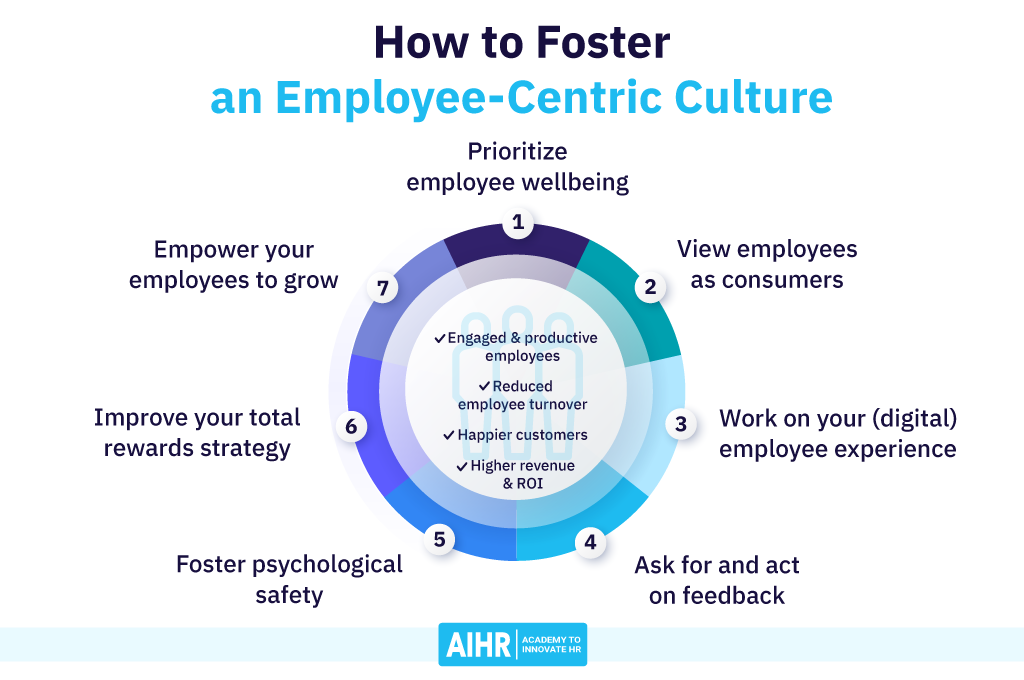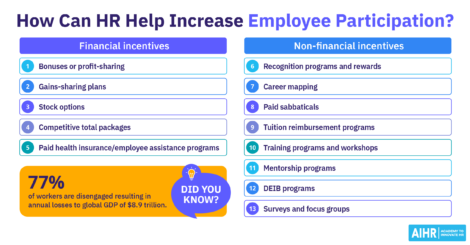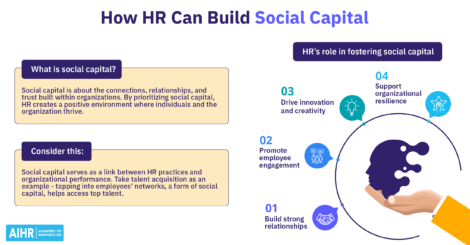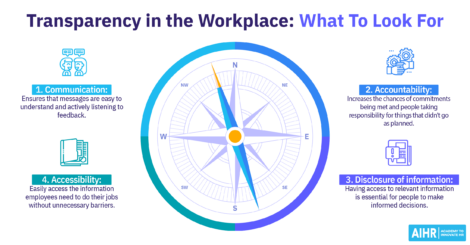7 Tips for Building an Employee-Centric Culture

Employee-centric culture benefits organizations in many ways, from improved productivity and retention to serving their customers better. Let’s dive into the definition and benefits of an employee-centric culture, plus explore how to foster such a culture at your organization.
Contents
What is an employee-centric culture?
Benefits of an employee-centric culture
How to foster an employee-centric culture
What is an employee-centric culture?
An organization with employee-centric culture welcomes open communication, encourages feedback, provides psychological safety, and inspires innovation. The workforce becomes the top priority.
When employees feel that their organization acts in their best interest, it contributes to their positive employee experience, resulting in an engaged, happy, and productive workforce.
In this work environment, everyone can fearlessly voice their ideas and suggestions without the fear of being reprimanded or facing repercussions.
Employees make up a company. So encouraging them to be creative and innovative is critical in growing your business.

Benefits of an employee-centric culture
Building an employee-centric organization has many benefits for the business:
Engaged and productive employees
Employee engagement accelerates when employees experience positive relationships with their direct supervisors and feel that their employer cares about them. These employee experiences include having a good rapport with their managers, having the right tools to perform their jobs, and having the authority and freedom to make work decisions, which are some of the key elements of an employee-centric company.
It all comes down to employees wanting to feel valued, respected, and recognized for their hard work. When employees feel accepted and are made comfortable in doing their jobs, they feel empowered and motivated to work harder. They can be their authentic self at work.
Highly engaged employees are more productive and committed to the organizations they work for. And engagement leads to productivity, which, in turn, helps the bottom line.
A study by Salesforce shows that feeling included, heard, and supported at work impacts employee productivity and satisfaction.
Reduced employee turnover
An enjoyable work environment where employees are the focus creates a positive employee experience. Happy, engaged employees are more likely to stay at their organizations longer.
On the contrary, a negative experience can prompt an employee to leave the organization abruptly, even without another employer. These reactions are results of unfavorable circumstances like lack of flexibility or perception of being underpaid.
Amid the Great Resignation and with growing global skill shortages, organizations must be employee-centric to retain exceptional staff that acts on business strategy while also reducing recruitment costs.
Happier customers
“Take care of your employees, and they’ll take care of your business”, said Richard Branson, founder of Virgin Group.
When HR and leadership teams create an employee-centric workplace that engages employees to do a good job – with fair pay, right workload balance, and strong company culture – they stimulate a positive attitude to work in their employees.
That positive attitude is carried over into their customer relationships, which results in happy and satisfied customers.
Happy customers are more likely to be loyal, promote your products and services to their friends and family and provide more feedback to help improve your offers. Ultimately, customer satisfaction, loyalty, and promotion result in repeat purchases that contribute to higher sales.
Higher revenue and ROI
A study by Willis Towers Watson revealed a compelling and predictive relationship between employee experience and the company’s superior financial performance.
The study found that high-performing companies have a very strong focus on how their employees feel about their organization: feeling inspired by the company’s mission and purpose, being able to achieve their career goals and having a deep trust with the higher management.
Other employee experience factors that are unique to high-performing companies include:
- employees’ basic understanding of work goals,
- local managers support its staff,
- and organizing work through scheduling and internal structures, efficient processes, and workplace flexibility.
How to foster an employee-centric culture
After considering the benefits of employee-centricity, here’s how you can apply the values of employee-centric culture in your organization:
1. View employees as consumers
As HR leaders, we should view employees as our customers. They have needs and wants that must be met, like the need to be heard, compensated well, and grow professionally.
We should move from a process-oriented approach to thinking about how we are designing the processes/workplaces to address these needs.
As such, we need to apply design thinking to adopt a human-centered approach that focuses on creating meaningful employee experiences, which starts with:
- Empathizing with employees first by understanding their needs and pains
- Moving to define the problem
- Brainstorming to identify and select the best HR ideas and solutions
- Building prototypes to test what works and what doesn’t
Here are some companies that have incorporated design thinking into their employee experience:
IBM: CHRO Diane Gherson used design thinking to improve the company’s learning and development programs. She said they had taken the ‘Netflix’ approach. Individuals create their own personalized learning platform with different channels, customized for their role, with ‘intelligent recommendations that are continuously updated.’ They are guided by a chat advisor regarding their course selections as well as ratings by colleagues who’ve studied the courses. On top of that, they also rolled out Net Promoter Scores to evaluate the training’s effectiveness.
Zappos: The company wanted to create a fun and unique experience for fresh hires. In their first month, new staff learns about the company’s history, core values, delivering WOW customer service, and forming meaningful bonds within the team via games, activities, and projects. Corporate Trainer Stepanie Hudec said the goal is to build relationships and ensure the new employees are comfortable in their role.
2. Work on your (digital) employee experience
As more organizations are embracing hybrid or remote work, people can choose work arrangements in which they can be most productive. The management team must invest in digital tools that support remote and hybrid work arrangements.
With this in mind, the digital employee experience (DEX) is becoming a more significant part of your total employee experience: in managing projects and workflows (Trello, Asana, Zapier); collaborating, and communicating with team members (Zoom, Microsoft Meetings); and accessing HR services like providing feedback (Officevibe), employee rewards (Fond), etc.
Whether it’s your first time getting these tools or updating your current set, consider how it contributes to an excellent digital employee experience:
- Ease of use and implementation
- Boosting productivity and efficiency
- Standardization of software usage (make sure everyone has access and uses the same tools to communicate with other teams)
- Mechanism to collect feedback before (software training) and after (usage) to gauge if tools were effective or if there are better tools out there
You need to develop your own digital dexterity to build an employee-centric digital organization. Enrolling in a Digital HR certificate program with a course on design thinking in HR will equip you with the knowledge and skills you need to design effective digital solutions and processes for your business.
Moreover, employee-centric organizations can also consider redesigning the physical workplaces to have more meeting and conference rooms to increase collaboration when people do come to the office.
3. Ask for and act on feedback
Talking about feedback, you need to solicit feedback from your employees to learn what is and what is not working at your organization.
Conducting stay interviews and exit interviews and organizing employee focus groups are great ways to hear what your employees have to say. Ask relevant questions about your organization’s employee experience like:
- How would you describe the employee experience at this organization?
- What employee experience initiatives would you like our organization to implement?
- Do you feel valued by the organization for what you do?
- What could the organization change to improve the employee experience?
- On a scale of 1 to 5 (1 = not at all, 5 = very), how would you rate your employee experience with our organization?
After you’ve analyzed the feedback, it’s time to come up with a game plan on how you’re going to improve things.
4. Foster psychological safety
When asking for feedback, it’s essential that employees feel they can speak up without worrying about being punished or humiliated.
By promoting mutual respect, leading by example with active listening, and fostering DEIB, you’re creating a psychologically safe environment for your employees to thrive in.
For instance, managers should advise employees that their responses will be kept confidential when they answer employee surveys. If you can, have a third-party vendor conduct the survey to soothe people’s fears of being identified on surveys.
Provide a safe space for employees to feel comfortable contributing to the conversation. Any references to actual people should be removed. Your workers should have an opportunity to give and receive feedback privately.
5. Improve your total rewards strategy
Design a total rewards strategy that considers and serves the varied needs of your employees. Identify elements that you need to focus on.
With compensation and monetary incentives, you should empower employees to understand their worth and compare your offer with the industry benchmarks or those offered by competitors.
Or, if your employees are leaving because of a lack of learning and development options, your renewed total rewards strategy might highlight employee development and career progression.
Another potential situation is people resigning because they want more work-life balance. By allowing employees to work remotely or have flexible working hours, you give them more time to focus on their personal lives.
6. Empower your employees to grow
A recent survey revealed that 58% of Millennials and 52% of Gen Z indicated that having successful careers depends on frequent upskilling and reskilling. Employees across generations who consistently engaged in learning reported feeling more fulfilled, accomplished and motivated.
It is imperative to give your employees opportunities to learn and grow.
To support this goal, implement a variety of L&D initiatives such as peer mentoring, micro-mentoring, formal and informal training, and targeted training.
Of course, this benefits you as an organization too. You will retain top talent and help make your organization more agile and resilient to adjust to unexpected shocks like the worldwide pandemic.
According to Peter Hirst, senior associate dean of executive education at the MIT Sloan School of Management, a culture of continuous learning is the mark of a healthy organization with engaged employees.
7. Prioritize employee wellbeing
When planning to improve employee wellbeing, you need to consider multiple aspects of wellbeing such as:
- physical wellbeing,
- mental wellbeing,
- emotional wellbeing,
- and financial wellness.
Start with researching initiatives that you can implement to boost employee wellbeing. Again, it’s essential to first address the most pressing needs of your employees.
In his book The Employee Experience Advantage, author Jacob Morgan said forward-thinking organizations understand that part of their responsibility is also looking after their employees and taking care of them.
He further noted that although employees usually experience the company’s health and wellness programs at work, they generally feel their impact at home. Employees who feel taken care of will feel more at ease and energized to spend time with their family and friends. They will feel better about themselves and, in general, will lead happier and healthier life.
To support your employees’ wellbeing:
- Create workspaces that promote health and wellness. They should be well-lit, good air quality, minimal noise, and ergonomically-designed furniture and equipment. Create guidelines for creating a healthy workspace at home for your remote and hybrid employees. Provide them with a budget to set up a home office if you can.
- Make sure that your organization’s safety policies adhere to industry standards.
- Offer healthy eating choices in the office cafeteria. Alternatively, you can provide meal vouchers to your remote and hybrid workers.
- Design smoke-free zones and places for physical activities.
Develop work policies that enhance people’s health and wellbeing including healthcare benefits and leave policies covering different types of leave. You can also add health perks to your total compensation strategies like gym and fitness club memberships.
Companies will experience reduced absenteeism and healthcare costs, enhanced employee morale, and lower turnover.
Conclusion
In an employee-centric culture, employees are supported, encouraged, and their ideas are requested and heard when making decisions about business practices, products, or services.
Fostering such a culture requires commitment but will help you build and retain an engaged workforce and customer base.
Weekly update
Stay up-to-date with the latest news, trends, and resources in HR
Learn more
Related articles
Are you ready for the future of HR?
Learn modern and relevant HR skills, online












